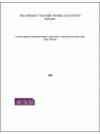This research, carried out by the Australian Council for Educational Research (ACER) in 2004, looks at the hours worked, the kinds of work performed and the manageability of that work, for principals, middle managers and teachers in New Zealand secondary schools. This study was a recommendation of the Ministerial Taskforce on Secondary Teacher Remuneration which reported in 2003. The research was commissioned by the Ministry of Education.
Purpose
The Ministerial Taskforce on Secondary Teacher Remuneration, which reported in November 2003, recommended that a study be undertaken to consider how the work of a secondary teacher, and particularly a middle manager, could be better structured and resourced in order to encourage effective classroom teaching. The research was commissioned by the Ministry of Education.
Key Results
The key findings of the study include:
- The research identified "moderate to severe" workload problems among teachers and managers in New Zealand secondary schools.
- The report noted that the actual number of hours worked by teachers and middle managers in secondary schools was high, but comparable with hours worked by teachers in other countries and by people in comparable professions.
- From both the survey and the case studies, the report noted that middle managers (mainly HODs) were clearly the group most affected by workload, largely related to their responsibilities in the areas of assessment, curriculum and performance review. Middle managers indicated that the difficulties experienced related less to the nature of the duties than to the lack of time and support to perform them.
- The research indicated that manageability of workload relates more to stress than to the number of actual hours worked. The report suggested that identified sources of stress need to be further investigated and addressed.
- A strong positive outcome of the findings was that middle managers and teachers were observed to be strongly motivated and committed to helping students achieve their academic and personal potential.
- Principals, middle managers and teachers see the most important factors in addressing workload and stress are: increased support to reduce workload/stress coming from the provision of additional [quality] staffing, and additional provision for time to do professional work outside of the classroom
.... so how hard do teachers work?
The total average hours per week worked by teachers without management responsibilities was 43 (based on teachers' own estimates at interview) or 49 (based on figures from the survey). The total average hours per week worked by middle managers was 51 (based on middle managers' own estimates at interview) or 59 (based on figures from the survey). This comprised scheduled classroom duties and management duties. The averages include weekends but not holiday periods.
Almost all teachers described their workload as `heavy', but said it was manageable, most of the time. A significant number said that at certain `peak' periods workload exceeded their capacity to manage it and that this negatively affected their teaching
.... what things create extra work or stress?
Different factors in different schools made a difference to teachers' perceptions of workload. These were: levels of personal commitment to teaching and students; support for and management of student behaviour/pastoral care; adequacy of resources and support; leadership and shared vision; development of best practice through professional communities and professional learning; effective use of ICT; amount of non-contact time; the number of support staff; compliance requirements, particularly paperwork associated with NCEA
.... how satisfied are teachers with their work?
Managers and teachers in schools showed very high levels of personal commitment to their work.
Teachers and senior managers, overall, were more satisfied with work-life balance than middle managers. Females were less satisfied with their workload and work-life balance than males.
New teachers, on average, found their work more manageable and were more satisfied with their workload and life-work balance than other teachers
.... what strategies had teachers and schools developed to manage workloads?
Teachers and schools have developed a range of strategies to facilitate managing of workloads, eg prioritising tasks, using support staff for non professional duties, minimising the number of meetings and using the meeting time more effectively, timetabling blocks of time for teachers to meet, and `filtering' the demands of outside agencies.
A valuable strategy for managing teachers' workload was that of capacity building - providing teachers with the knowledge and skills they needed to work as competent professionals. More effective performance lightens workload and increases job satisfaction.

